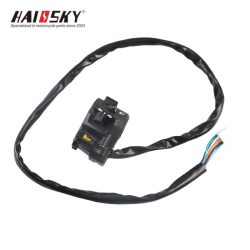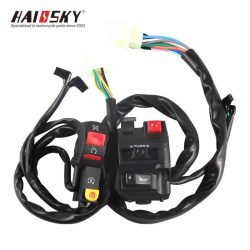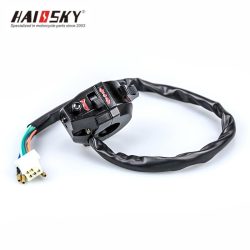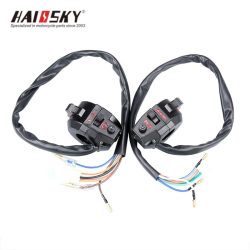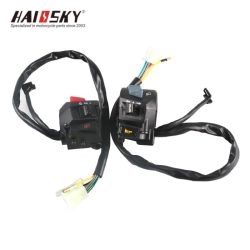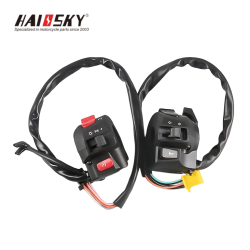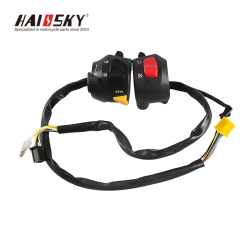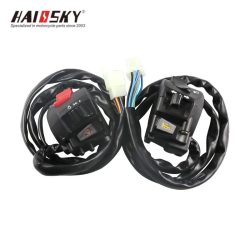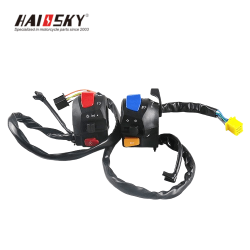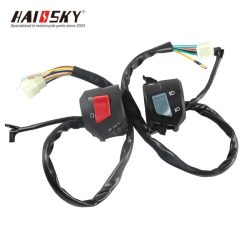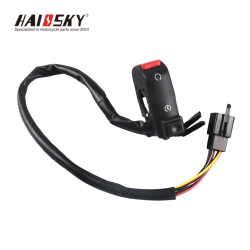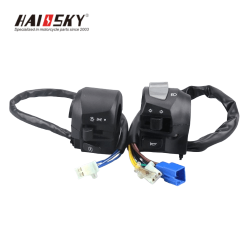OEM Motorcycle Parts
Category: Motorcycle Handle Switches
Everything You Need to Know About Motorcycle Speed Switches
When it comes to motorcycle performance and safety, the motorcycle speed switch plays a crucial role. This component is essential for managing speed-related functions, ensuring smooth operation, and enhancing rider control. At Haissky.com, we specialize in providing high-quality motorcycle speed switches to B2B wholesalers and riders. In this guide, we’ll explore the types of speed switches, their functions, maintenance tips, and how to choose the right speed switch for your motorcycle. We’ll also answer some frequently asked questions to help you make informed decisions.
What Is a Motorcycle Speed Switch?
A motorcycle speed switch is an electronic or mechanical device that controls speed-related functions, such as speedometer operation, cruise control, or speed limiters. It ensures accurate speed readings and helps maintain optimal performance and safety. Speed switches are often integrated into the motorcycle’s electrical system, working in tandem with sensors and control units.
Types of Motorcycle Speed Switches
Motorcycle speed switches come in various types, each designed for specific functions and applications. Here are the most common types:
1. Speed Sensor Switches
Speed sensor switches detect the rotational speed of the wheels and transmit this data to the speedometer or ECU. They are essential for accurate speed readings and performance monitoring.
Pros: Accurate speed detection, essential for modern motorcycles.
Cons: Requires proper calibration and maintenance.
2. 3-Speed Switches
3-speed switches allow riders to select between different speed modes, such as low, medium, and high. These switches are commonly used in electric motorcycles or scooters.
Pros: Enhances control and efficiency.
Cons: Limited to specific motorcycle models.
3. Clutch Switches
Clutch switches are activated when the rider engages the clutch lever. They ensure the motorcycle’s engine and transmission operate smoothly during gear changes.
Pros: Improves gear shifting and engine performance.
Cons: Can wear out over time, requiring replacement.
4. Kill Switches (Red Switch)
The kill switch, often marked by a red button, is a safety feature that allows riders to quickly shut off the engine in emergencies.
Pros: Enhances safety and control.
Cons: Misuse can lead to engine stalling.
5. Cruise Control Switches
Cruise control switches enable riders to maintain a constant speed without holding the throttle. They are ideal for long-distance rides.
Pros: Reduces rider fatigue and improves comfort.
Cons: Limited to motorcycles with cruise control systems.
Functions of a Motorcycle Speed Switch
The speed switch performs several essential functions, including:
Speed Detection: Ensures accurate speed readings for the speedometer and ECU.
Speed Control: Allows riders to select different speed modes or maintain a constant speed.
Safety: Enhances safety by enabling quick engine shutdown or smooth gear changes.
Performance Monitoring: Provides real-time data for optimal engine and transmission performance.
Maintenance Tips for Motorcycle Speed Switches
Proper maintenance ensures the longevity and performance of your motorcycle speed switch. Here are some key tips:
1. Regular Inspection
Inspect the speed switch and its connections for signs of wear, corrosion, or damage.
2. Cleanliness
Keep the switch and surrounding area clean to prevent dirt and debris from affecting its operation.
3. Lubrication
Lubricate moving parts, such as clutch switches, to ensure smooth operation.
4. Check Wiring
Ensure all wiring connections are secure and free from damage.
5. Replace Worn Parts
Replace any worn or damaged switches promptly to avoid performance issues.
How to Choose the Right Motorcycle Speed Switch
Selecting the right speed switch depends on your motorcycle’s make, model, and performance needs. Here are some factors to consider:
1. Compatibility
Ensure the speed switch is compatible with your motorcycle’s electrical system and specifications.
2. Functionality
Choose a switch that meets your specific needs, such as speed detection, cruise control, or safety features.
3. Durability
Opt for switches made from high-quality materials that can withstand harsh riding conditions.
4. Ease of Installation
Select switches that are easy to install and come with clear instructions.
5. Budget
Set a budget and choose a switch that offers the best value for money without compromising on quality.
How to Replace a Motorcycle Speed Switch
Replacing a motorcycle speed switch is a straightforward DIY task if you have the right tools and knowledge. Here’s a step-by-step guide:
Tools Needed:
Screwdrivers
Wrenches
Multimeter (for testing electrical connections)
New speed switch
Steps:
Prepare the Motorcycle: Turn off the engine and disconnect the battery.
Locate the Switch: Identify the speed switch’s location on your motorcycle.
Remove the Old Switch: Disconnect the wiring and remove the old switch using appropriate tools.
Install the New Switch: Connect the new switch to the wiring and secure it in place.
Test the Switch: Reconnect the battery and test the new switch to ensure it functions correctly.
Reassemble: Reassemble any disassembled parts and ensure all connections are secure.
Frequently Asked Questions
Q1: What is the difference between a speed sensor and a speed switch?
A speed sensor detects wheel rotation and transmits data, while a speed switch controls speed-related functions like speedometer operation or cruise control.
Q2: How does a 3-speed switch work?
A 3-speed switch allows riders to select between low, medium, and high-speed modes, enhancing control and efficiency.
Q3: What is the clutch switch for on a motorcycle?
The clutch switch ensures smooth engine and transmission operation during gear changes by detecting clutch lever engagement.
Q4: What does the red switch on a motorcycle do?
The red switch, or kill switch, allows riders to quickly shut off the engine in emergencies.
Q5: What are the symptoms of a bad speed sensor?
Symptoms include inaccurate speedometer readings, cruise control failure, and check engine lights.
Q6: How does a speed switch work?
A speed switch controls speed-related functions by sending signals to the motorcycle’s electrical system, such as activating the speedometer or cruise control.
Conclusion
Motorcycle speed switches are essential components that enhance performance, safety, and control. Whether you’re a B2B wholesaler or a rider, understanding the types, maintenance, and selection of speed switches is crucial for optimal functionality.
At Haissky.com, we offer a wide range of high-quality motorcycle speed switches designed to meet the needs of every rider. Explore our collection today and find the perfect speed switch for your inventory or personal use!


